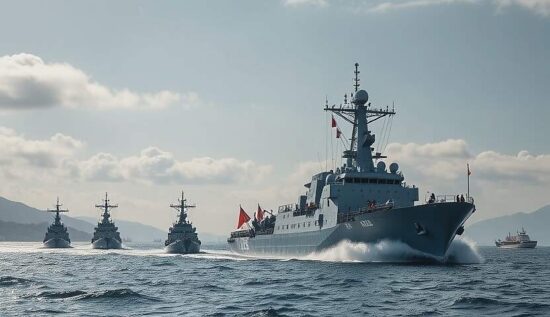China may have built the world’s largest unmanned submarine. At least, that’s what experts infer from satellite images of a highly unusual submarine under construction at a shipyard in southern China, with no information available on the project so far.
Even the US recognizes China’s colossal progress in shipbuilding. “China is accelerating the pace of shipbuilding and its capabilities in this area far surpass ours” says the new Pentagon chief, Keith Hegseth.
As late as January, a new frigate was commissioned into the Chinese People’s Liberation Army Navy. It is a ship of the type known in the Western media as the Type 054B. This ship represents a continuation of the development of Chinese frigates of the 054/054A project and its modifications. The development of this ship series is very enlightening, as it reflects the principles by which China has managed to build the world’s largest navy in a historically short period of time.
In the early years of the People’s Republic of China, the navy was a secondary goal of the Chinese military and political leadership. Initially, the country was not interested in and was underdeveloped and dependent on the Soviet Union. In the 1950s, the Soviet Union transferred a series of small ships and some production technologies to China and the Chinese began building coastal warships that, however, were rather weak.
In general, the People’s Republic of China in this period until the early 21st century relied on copying foreign (mainly Soviet) designs or creating its own variants based on them. The Chinese developed their own patrol ship project 065 on the basis of the Soviet patrol ship project 50 and then in the 1960s a series of destroyers project 051 on the basis of the Soviet destroyer project 41.
Almost 40 years, from 1965 (the start of the development of their own ships) to the second half of the 2000s, when the old projects were replaced, the Chinese built 17 destroyers and 49 frigates from relatively large ships. These ships were much more primitive than their Soviet or American “colleagues”. At that time, the Chinese economy was too weak to build a massive and powerful navy.
Another characteristic of the Chinese shipbuilding was that China had a limited, but relevant combat experience in naval warfare.
In 1974, China, in the face of the aggression of the Saigon regime, launched a military operation to capture the Paracel Islands and defeat the South Vietnamese naval forces in the area of the archipelago. This showed the Chinese leadership that the navy was an extremely useful instrument of war. Later, in the conflicts over the Spratly Islands, as the Chinese navy was already operating against the united Vietnam, this was confirmed again.
From an ideological perspective, the Chinese navy developed from a purely defensive force to a fleet that could engage the enemy at a greater distance from the Chinese coast (which was strongly fostered by Soviet influence on Chinese admirals’ thinking). Later, it became a means of achieving supremacy at sea in an ever greater distance from the Chinese coast. In this form, the Chinese naval power has since the mid-2000s entered an era of rapid economic and industrial growth and the technological progress in China has also changed the way the People’s Republic of China built its navy.
Principles of a naval power and China
There are rules for building a strong navy that are binding for every country that wants to have such a military instrument. In the most vivid form, the United States, during the Reagan administration, resorted to these rules. In those years, the US had a program of “600 ships” aimed at achieving a crushing superiority in naval power over the Soviet Union. Later, the then-US Navy Secretary, John Lehman, repeatedly outlined the principles of shipbuilding that enabled the construction of a powerful fleet. It’s worth recalling them briefly.
First, no unnecessary innovations. A warship is built with already established ship systems. At the time of the start of the construction, all ship systems must have already been successfully tested on the test stand or be already in production. If this principle is not followed, either unfinished or insufficiently armed ships will be delivered, or the construction time will be affected due to the time needed for the completion of the ship systems.
Second, no changes to the ship design after the contract is signed. The series must be built as agreed. All design changes should only be made in the framework of other contracts for modifications of the ship.
Third, one must proceed moderately. Between the achievement of the ultimate parameters of a ship or its simplicity and mass production, one should decide on the latter. Many ships with average capabilities are stronger than one or two ultra-perfect ships for the same money.
Fourth, the ships should be built in a series of a large number of identical units. Only in this way can the uniformity of combat training be ensured, the supply of spare parts for the fleet simplified and money saved on construction costs.
In this way, the Americans acted and in the 1980s, the world’s oceans were flooded with destroyers of the Spruance class and frigates of the Perry class, built to the tune of dozens. It was impossible to neutralize such a mass.
The Chinese have learned this lesson very well. Their own experiences with the project 053 also spoke for the same thing – it is necessary to establish a massive quantity of average, but not weak, warships and to prevent this mass from being overwhelmed by technologically superior ships by having a powerful fist of smaller, but more advanced and more powerful ships that can work together with the “mass”.
By the mid-2000s, the Chinese economy had grown large enough to support a more intense naval buildup and China’s survival depended heavily on sea communication. This required a navy and at that time, the People’s Republic had everything it needed to build a sea force.
The Middle Kingdom always planned to acquire aircraft carriers as combat units. As we know, China was successful in this, but initially, it went with destroyers of the projects 052, 052B and several variants of project 051, with only a few ships built, sometimes two at a time, but the series of frigates – various modifications of project 053 – was planned for a large series.
In 2003, two new frigates of the type project 054 were commissioned. It was a beautiful, modern-looking ship that resembled French ships and had radar-absorbent rumps and superstructures that met the requirements of radar camouflage. The ships were equipped with a frugal diesel engine and only conventional weapons.
During the construction, the fruits of cooperation with Russia in the form of new, more advanced radar stations, vertically launched air defense missile systems and much more were obtained. All this was tested and verified and a new design of the frigate 054A with these weapons was developed and the appearance of the series was frozen. The world witnessed what is now called China’s shipbuilding conveyor belt – since 2008, the Chinese have been producing two to four identical frigates every year.
Since the design was not changed, they could issue mass orders for ship subsystems and components and build, build, build. Between 2008 and 2023, Chinese shipbuilders delivered 40 frigates of the project 054A alone for their fleet and built four more for export.
By the mid-2010s, these ships were aging, but China decided on quantity and was not willing to slow down the pace. The further improvement of the series was delayed, until all ship systems of the new generation were built, tested and ready for mass production. Parallel to this, the People’s Republic was building anti-submarine corvettes of the project 056. According to the same scheme, the production of large destroyers with the project 052D and later 055 was also strongly accelerated.
In 2022, the Chinese were ready for the new 054 project and a ship with new systems was designed. Thanks to the experience of the massive series of earlier 054A projects, it was designed and put into service within a year and even ships of the previous project were still in the making. Now the ship is in service.
What would happen if the Chinese tried to install every new radar or jamming system on a ship already in the making? Only a delay in the completion of the ship would result. The number of ships would suffer. And the fact that three ships are stronger than one is self-evident.
A new level
Quantity is now giving way to quality and the new Chinese frigate is an example of this transition. The updated 054 is indeed larger, but it is essentially the same ship. It has the same diesel engines as the 054A, only newer. The electronic warfare equipment was updated and active phased-array radars were installed. In total, the ship is unchanged, but also new, more powerful and more efficient.
Now, the Chinese shipbuilding conveyor belt is planned and without interruptions, switching to a new ship type. Already, modern frigates of the same pace – several ships per year – are being built.
After the birth of the new modification, the frigate Lohe, followed by the second ship of the same project, the Qinzhou, which is already in testing. At the same time, China has ten more older models, only slightly improved ships of the project 054A in the making – they will be completed by the time the new project is confirmed, in case something goes wrong with the new project. When the project 054B is confirmed, the ships of the type project 054A will already be completed.
The new frigate says two things. First, the technical level of the Chinese navy will continue to rise and its ships will keep pace with design changes over time. And second, the shipbuilding in China is being done by people who very well understand what they are doing and why they are doing it. And that is much more important than just a new modification of a known ship.





